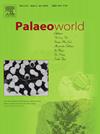Anatomy and paleoclimatic implications of Cenozoic Coryphoideae palm wood species in Egypt
IF 1.7
3区 地球科学
Q2 PALEONTOLOGY
引用次数: 0
Abstract
This study examines 12 well-preserved specimens collected from the Miocene Moghra and Gebel Khashab formations at six sites in the northern part of the Western Desert of Egypt. The results reveal distinct anatomical features for each of the four morphospecies (namely Palmoxylon aschersoni Schenk, P. cf. aschersoni Schenk, P. lacunosum (Unger) Felix, and P. libycum (Stenzel) Kräusel), confirming their identification and classification within the subfamily Coryphoideae. The paleoclimatic conditions for each species are interpreted based on key ecologically-based anatomical traits, such as the number of metaxylem elements and the nature of ground tissue. These findings indicate that the four recorded species reflect different paleoenvironments and depositional conditions, suggesting that they were transported by water from their original growth sites to their current locations, resulting in an intermingling of forest forms in the northern Western Desert. An overview of the fossil record of the subfamily Coryphoideae in Africa is also provided.
埃及新生代叶蕨科棕榈树种的解剖学和古气候意义
这项研究检查了在埃及西部沙漠北部的六个地点从中新世Moghra和Gebel Khashab地层收集的12个保存完好的标本。结果揭示了四个形态种(Palmoxylon aschersoni Schenk, P. cf. aschersoni Schenk, P. lacunosum (Unger) Felix和P. libycum (Stenzel) Kräusel)各自的解剖特征,证实了它们在蕨亚科中的鉴定和分类。每个物种的古气候条件都是基于关键的生态解剖学特征来解释的,比如韧皮部元素的数量和地面组织的性质。这些发现表明,这四种记录物种反映了不同的古环境和沉积条件,表明它们被水从原始生长地点转移到现在的位置,导致西部沙漠北部森林形式的混合。本文还概述了非洲斑蝶亚科的化石记录。
本文章由计算机程序翻译,如有差异,请以英文原文为准。
求助全文
约1分钟内获得全文
求助全文
来源期刊

Palaeoworld
PALEONTOLOGY-
CiteScore
4.00
自引率
5.90%
发文量
95
期刊介绍:
Palaeoworld is a peer-reviewed quarterly journal dedicated to the study of past life and its environment. We encourage submission of original manuscripts on all aspects of palaeontology and stratigraphy, comparisons of regional and global data in time and space, and results generated by interdisciplinary investigations in related fields. Some issues will be devoted entirely to a special theme whereas others will be composed of contributed articles. Palaeoworld is dedicated to serving a broad spectrum of geoscientists and palaeobiologists as well as serving as a resource for students in fields as diverse as palaeobiology, evolutionary biology, taxonomy and phylogeny, geobiology, historical geology, and palaeoenvironment.
Palaeoworld publishes original articles in the following areas:
•Phylogeny and taxonomic studies of all fossil groups
•Biostratigraphy, chemostratigraphy, chronostratigraphy
•Palaeoecology, palaeoenvironment and global changes throughout Earth history
•Tempo and mode of biological evolution
•Biological events in Earth history (e.g., extinctions, radiations)
•Ecosystem evolution
•Geobiology and molecular palaeobiology
•Palaeontological and stratigraphic methods
•Interdisciplinary studies focusing on fossils and strata
 求助内容:
求助内容: 应助结果提醒方式:
应助结果提醒方式:


